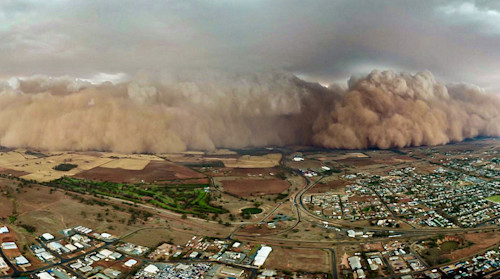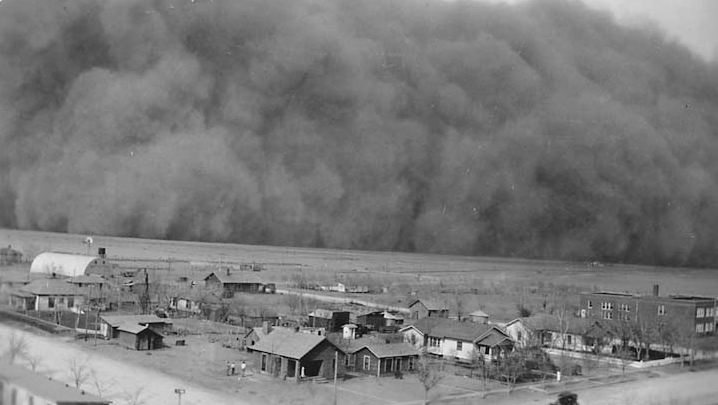Welcome to DU!
The truly grassroots left-of-center political community where regular people, not algorithms, drive the discussions and set the standards.
Join the community:
Create a free account
Support DU (and get rid of ads!):
Become a Star Member
Latest Breaking News
Editorials & Other Articles
General Discussion
The DU Lounge
All Forums
Issue Forums
Culture Forums
Alliance Forums
Region Forums
Support Forums
Help & Search
Environment & Energy
Related: About this forumWas shocked to see hazy sky all the way to the ground Tuesday when going down road to get the mail
First thought was that my glasses needed cleaning. Then realized that was DUST! Heard this dust was blowing in from West Texas and New Mexico (reckon called 'New America' now).

Today's NASA Earth Observatory has a striking image of just how extensive these dust storms were.
...Exceptional drought has gripped West Texas for the past several months, according to the U.S. Drought Monitor. The lack of rain has parched vegetation and dried the land surface, making the region particularly susceptible to erosion and dust storms.
Fierce winds and thick plumes of blowing dust led to traffic accidents, flight disruptions, school closures, power outages, and red and orange skies throughout the state and region, according to news reports. One particularly severe dust storm on March 3 sharply reduced visibility and contributed to a 21-car accident near Roswell, New Mexico...
https://earthobservatory.nasa.gov/images/154015/storm-brings-a-potpourri-of-hazards-to-the-us
Here in Bexar we were just on the fringes. Have been up close with such in New Mex in past. Unpleasant.
Fierce winds and thick plumes of blowing dust led to traffic accidents, flight disruptions, school closures, power outages, and red and orange skies throughout the state and region, according to news reports. One particularly severe dust storm on March 3 sharply reduced visibility and contributed to a 21-car accident near Roswell, New Mexico...
https://earthobservatory.nasa.gov/images/154015/storm-brings-a-potpourri-of-hazards-to-the-us

A couple of years ago read a wonderful book—Dust, by Jay Owen—which takes a close look at the science and politics of earth turning to dust. The Guardian has a nice book review of the work:
...Dust, in Owens’s view, is “intensely political”. Early in the book, for example, she unpacks (all too briefly) the history of hygiene, exploring how dirt and our relation to it has changed over centuries, and cleanliness – or the pursuit of it – defines our modern lives. After the Industrial Revolution, emerging ideas about the relationship between dirt and disease made dust something to be fought against – a responsibility that inevitably fell on women and minorities. The poorest people tended to have the least time and money to clean a house; often, their jobs were to clean the houses of others. “The history of 20th-century cleanliness is, thus, a history not only of the making of gender and class distinctions, but racialised inequalities.”
Perhaps the most haunting chapter in the book is that in which Owens retells the story of the nuclear age not through mushroom clouds, but through the radioactive dust they left behind. One study by International Physicians for the Prevention of Nuclear War estimated that the effects of atmospheric nuclear testing would eventually result in the deaths of 2.4 million people from cancer, a threat “that has gone substantially unnoticed because radioactive dust is such a diffuse and delayed killer”. Between 1945 and the signing of the test ban treaty in 1963, America was exposing “tens of thousands” of its own citizens to the direct effects of nuclear explosions. Indigenous communities were particularly affected. Extensive uranium mining was performed on Navajo land, and in 2015 a study found that dust in 85% of Navajo homes contained the radioactive metal...
https://www.theguardian.com/books/2023/aug/17/dust-by-jay-owens-review-the-stuff-that-surrounds-us
Perhaps the most haunting chapter in the book is that in which Owens retells the story of the nuclear age not through mushroom clouds, but through the radioactive dust they left behind. One study by International Physicians for the Prevention of Nuclear War estimated that the effects of atmospheric nuclear testing would eventually result in the deaths of 2.4 million people from cancer, a threat “that has gone substantially unnoticed because radioactive dust is such a diffuse and delayed killer”. Between 1945 and the signing of the test ban treaty in 1963, America was exposing “tens of thousands” of its own citizens to the direct effects of nuclear explosions. Indigenous communities were particularly affected. Extensive uranium mining was performed on Navajo land, and in 2015 a study found that dust in 85% of Navajo homes contained the radioactive metal...
https://www.theguardian.com/books/2023/aug/17/dust-by-jay-owens-review-the-stuff-that-surrounds-us
NB: the above image (a cropped version was used on Guardian page) was taken by Jason Davies and the version I used is from a Weather Network article on that storm and has many other images
https://www.theweathernetwork.com/en/news/nature/animals/massive-dust-storm-damaging-hail-and-flash-flood-hit-australia-brisbane-melbourne-canberra-nsw-victoria
Sadly, little has really been done to deal with the politics of dust since our last Dust Bowl years of the 1930s

The National Drought Mitigation Center of the University of Nebraska has a great website where we might learn a bit about what is coming as the world heats and droughts get deeper
...In the 1930s, drought covered virtually the entire Plains for almost a decade (Warrick, 1980). The drought’s direct effect is most often remembered as agricultural. Many crops were damaged by deficient rainfall, high temperatures, and high winds, as well as insect infestations and dust storms that accompanied these conditions. The resulting agricultural depression contributed to the Great Depression’s bank closures, business losses, increased unemployment, and other physical and emotional hardships. Although records focus on other problems, the lack of precipitation would also have affected wildlife and plant life, and would have created water shortages for domestic needs.
Although the 1930s drought is often referred to as if it were one episode, there were at least 4 distinct drought events: 1930–31, 1934, 1936, and 1939–40 (Riebsame et al., 1991). These events occurred in such rapid succession that affected regions were not able to recover adequately before another drought began.
Effects of the Plains drought sent economic and social ripples throughout the country. For example, millions of people migrated from the drought areas, often heading west, in search of work. These newcomers were often in direct competition for jobs with longer-established residents, which created conflict between the groups. In addition, because of poverty and high unemployment, migrants added to local relief efforts, sometimes overburdening relief and health agencies...
https://drought.unl.edu/dustbowl/
Although the 1930s drought is often referred to as if it were one episode, there were at least 4 distinct drought events: 1930–31, 1934, 1936, and 1939–40 (Riebsame et al., 1991). These events occurred in such rapid succession that affected regions were not able to recover adequately before another drought began.
Effects of the Plains drought sent economic and social ripples throughout the country. For example, millions of people migrated from the drought areas, often heading west, in search of work. These newcomers were often in direct competition for jobs with longer-established residents, which created conflict between the groups. In addition, because of poverty and high unemployment, migrants added to local relief efforts, sometimes overburdening relief and health agencies...
https://drought.unl.edu/dustbowl/
3 replies
 = new reply since forum marked as read
Highlight:
NoneDon't highlight anything
5 newestHighlight 5 most recent replies
= new reply since forum marked as read
Highlight:
NoneDon't highlight anything
5 newestHighlight 5 most recent replies
Was shocked to see hazy sky all the way to the ground Tuesday when going down road to get the mail (Original Post)
SorellaLaBefana
Mar 2025
OP
MLAA
(19,331 posts)1. Around 2012 I was living in Shanghai and had to fly to Beijing. Arriving on the first flight out that morning I looked
out the window and couldn’t see more than a couple of feet. There was a thick yellow- grey haze that made it look dystopian landscape post apocalypse, There are pics at the link below of a recent such sandstorm.
https://www.bbc.com/news/world-asia-china-56399267
SorellaLaBefana
(378 posts)2. That must have been both exciting and dreadful
Thanks for sharing
MLAA
(19,331 posts)3. I lived there for 4 years and overall an amazing experience. The local people I met and worked with were wonderful.
Part of it was during the Expo and the air quality was really improved for that entire time in Shanghai. Best work experience of my life.